italians and formula 1 - part one
from fiat to ferrari
by Christopher Pepe
(return to sports)
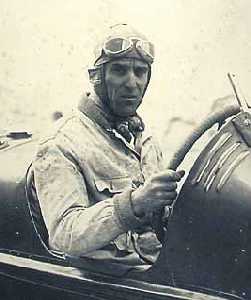 For many years, Italian automobile manufacturers have been praised for creating beautiful
and powerful machines of style and grace. Never accused of creating a brutta figura, manufacturers such as
Alfa Romeo, Maserati and Ferrari have confidently produced automobiles worthy of the autostrada and the Grand
Prix.
For many years, Italian automobile manufacturers have been praised for creating beautiful
and powerful machines of style and grace. Never accused of creating a brutta figura, manufacturers such as
Alfa Romeo, Maserati and Ferrari have confidently produced automobiles worthy of the autostrada and the Grand
Prix.
While Grand Prix, or Formula 1 racing, was not invented by the Italians, it has been repeatedly influenced
by their sleek designs and innovative power. Many would agree that despite fierce competition from their
French and German neighbors, Italy has consistently set the standard for Formula 1 racing.
The Early Years
The Birth of the Grand Prix in France
The first organized Grand Prix covered a distance of 126 km and was actually a "Reliability Trial Run." It was
held in France, and was run from Paris to Rouen. The trial run was organized in 1894 by a newspaper, Le Petite
Journal, and the winning automobile would be a horseless carriage deemed to be "safe, easily controllable and
reasonably economical to run." Twenty-one entries left Paris on July 22nd, and the first to reach Rouen was the
Count de Dion in a steam driven De Dion tractor. However, the jury decided that the Count's car was not a "practical
road vehicle" and instead awarded the prize jointly to the next two leading cars, a Peugeot and a Panhard-Levassor
respectively. The winning average speed? An exhilarating 17km/h.
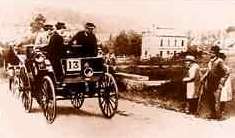 The following year, a true "race" was run from Paris to Bordeaux and back. This 1895 event was won by Emile Levassor,
driving a 2-cylinder, 4-bhp Panhard-Levassor which he drove for 48 hours 48 minutes virtually non-stop. One
feature of the 1895 event was the Peugeot of Andr� Michelin which used pneumatic tires (in this era, wheels
used on other cars were either iron or solid rubber).
The following year, a true "race" was run from Paris to Bordeaux and back. This 1895 event was won by Emile Levassor,
driving a 2-cylinder, 4-bhp Panhard-Levassor which he drove for 48 hours 48 minutes virtually non-stop. One
feature of the 1895 event was the Peugeot of Andr� Michelin which used pneumatic tires (in this era, wheels
used on other cars were either iron or solid rubber).
The immediate years that followed saw an ever-increasing search for speed. The easiest path to greater speeds
was to increase engine size, and soon 7 and 8 liter engines were common place. In 1901, Mercedes broke the
mould with the introduction of a 35 hp automobile. After solving some early reliability problems (and an
increased engine capacity to 9 liters producing 60 hp), the car became a consistent race winner.
In 1906, the French held the very first Grand Prix for manufactures over a 64-mile course near Le Mans. Of the
32 cars that started the race, 11 remained after 12 laps (split over two days). The winner was Ferenc Szisz, a
Hungarian, driving a 90 hp Renault. His Renault utilized detachable rims created by Michelin, enabling him to
change tires in 2 to 3 minutes instead of the normal 15 minutes. And Renault helped the French continue their
domination of the early years of the Grand Prix.
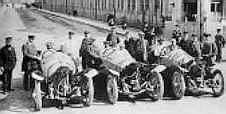 The Italians Take the Lead
The Italians Take the Lead
Breaking French Domination
1907 was the year of the Italians. Taking to the field with cars from Fiat,
Itala and Isotta-Fraschini, Italians managed to win most
of the major races and finally break the domination of the French. The second French Grand Prix was staged
under a new set of rules based on fuel consumption, effectively putting a stop to the quest for ever-larger
engines.
Also in 1907, three new races were born. First, Germany staged the first of the Kaiserpreis races, where racing
cars were not permitted, to the exclusion of touring cars with engines of less than eight litres.
The race was won by Felice Nazzaro, in a Fiat. That year Nazzaro had also won the French
Grand Prix and the Targa Florio, created by the wealthy Sicilian Vicenzo Floria. Second, the Coppa Florio,
held near Brescia in Italy, was run along the lines of the Kaiserpreis and saw Ferdinando Minoia winning in an
Isotta-Fraschini. The third major event was a race sponsored by the Paris newspaper Le Matin. Run from Peking
to Paris, this 15,000 kilometre event took cars through some of the worst terrain Asia and Europe could throw
at them. This race was also won by an Italian, this time driving an Itala. The Itala drivers finished the
course in exactly two months. A further two months were to pass before the second placed car arrived back in
Paris, thus making for the largest ever winning margin in a road race!
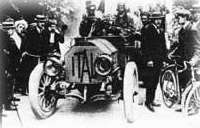 Economic Problems and the Advent of War
Economic Problems and the Advent of War
The racing industry contracts
From 1909 onwards there was a marked reduction in the number of races being staged. Economic depression seriously
affected the European motor industry and several major manufacturers withdrew from racing. Most notable was
Renault who did not rejoin the top line motor sport until 1977. Also, the cost of trying to stay ahead of the
constant race changes were too great for most of the manufacturers, and many withdrew.
The United States makes a move
The depression had less impact in the USA and racing entered a period of rapid expansion. American drivers had
spent the first twenty years of racing being totally dominated by their European counterparts. Things started
to change in 1909 with the opening of the Indianapolis Motor Speedway.
The spectators loved it from the start. Not only could they see the entire track at the same time, but the
design made for extremely competitive and exciting racing. The racing promoters agreed with them. Crowds could
at last be controlled and charged an entry fee. Oval circuits sprung up all over the US and by 1917 the
American Automobile Association was staging the national championship races exclusively on such circuits. By
now, however, it was common knowledge that Europe was slipping towards war. As war swept across Europe, the
roar of engines fell away to be replaced with the sound of cannon fire. They did not return for almost seven
years.
 Racing Returns
Racing Returns
The rise of Fiat and Alfa Romeo
World War I inflicted serious damage on the sport of auto racing, best exemplified at the 1921 French Grand
Prix where the Europeans were overwhelmed by the visiting Americans. However, European engineers had learned a
lot during the war, and European cars were soon experiencing some incredible technological advances.
Overhead camshafts and supercharged engines soon became the norm and the Europeans quickly regained their
dominance over the racing circuit. Among the most dominant forces of the European automobile renaissance were
the Italian outfits of Fiat and Alfa Romeo.
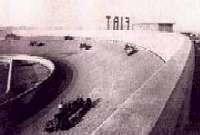 The growth of the Grand Prix
The growth of the Grand Prix
The twenties saw a massive swing towards small purpose built circuits. Between 1921 and 1927 the number of
Grand Prix increased steadily each year, with races being run in Italy, France, Spain, Britain and Belgium.
In 1925, the first attempt at a World Championship was made, with organisers nominating the Belgian, French
and Italian Grand Prix, and the Indianapolis 500, as championship events. This was a contest between
manufacturers and Alfa Romeo was the first to take the laurels. In 1926 the title went to Bugatti
whose stunning T39 model proved very hard to beat. The 1927 title went to Delahaye and then for 1928 the rules
governing racing were relaxed and the sport entered the era of Formula Libre.
 Formula Libre
Formula Libre
Free form racing propels Bugatti, Alfa Romeo and Maserati
Since the inception of Grand Prix racing in 1907, races had been run in accordance with a strict formula based
on engine size and weight. These regulations were all but abandoned in 1928, as organisers ran their events
under 'Formula Libre' rules - a free formula without weight, fuel consumption or distance limitations. This
relaxation resulted in a great deal of success for Italian racing car manufactureres Bugatti, Alfa Romeo and
the newcomer, Maserati.
But it was Bugatti with its supercharged Type 35B that dominated all of the major races in Europe. Bugatti
drivers William Grover Williams and Louis Chiron took all of the major trophies, including the first-ever
Monte Carlo Grand Prix in 1929. (note: The Bugatti race cars were some of the most beautiful cars ever built
but suffered from inadequate brakes. A famous quote attributed to Ettore Bugatti after criticism of his brakes
was: " I build my cars to go, not stop.").
 Ferrari enters the fold
Ferrari enters the fold
In 1930, Alfa Romeo decided to enlist some help in taking on their old rivals, and recruited a new company to
direct all of their racing efforts. This company was called Scuderia Ferrari
and was run by Enzo Ferrari. Alfa Romeo saw some immediate dividends with Tazio Nuvolari's victory in the
Mille Miglia. (note: The Mille Miglia was designed as a way to promote and improve Italian motor car design
and reliability. The race provided a test of almost 1000 grueling miles of good, bad, and indifferent roads.
The route traveled east to Vicenza, south along the Adriatic to Pescara, west to Rome and then northwest to
Brescia. It was the province of Italian drivers for most of its history. Traditionally the first cars, the
amateurs, would leave Brescia at 9 p.m. at 1-minute intervals and return 16-24 hours later. Due to the amount
of entrants, the works teams would often depart the next morning. Each car would have its starting time
painted on the car, which would allow spectators some indication of their relative placement. Nuvolari's
victory was the first in which the event had been completed at an average speed in excess of 100kph.) However,
lasting Grand Prix success for the operation did not come quickly.
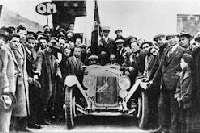 Despite Ferrari's entrance into the field and Nuvolari's win, Bugatti still dominated the season. And the
impressive eight-cylinder Maserati's remained a distant second, managing a couple of wins.
Despite Ferrari's entrance into the field and Nuvolari's win, Bugatti still dominated the season. And the
impressive eight-cylinder Maserati's remained a distant second, managing a couple of wins.
Bugatti and Alfa Romeo battle for the lead
For 1931, as Formula Libre continued, the only stipulation imposed on organisers of Grand Prix events was that
the race be run over a minimum period of 10 hours. That resulted in a two man team for each car and the rule
was adopted for the French, Italian and Belgian races. Bugatti fielded the T51 while Alfa Romeo unveiled their
twin-engined Type A Monoposto. Bugatti won four of the six Grand Prix, with Alfa scoring at the Italian Monza.
At this time the German Grand Prix, staged at the N�rburgring, was run under sportscar rules. It was won by
Rudolf Carracciola in a Mercedes SSK. Carracciola also made the news by winning the Mille Miglia, for this was
the first time the prestigious event had been won by anyone other than an Italian.
Alfa Romeo hoped for great things in 1932 when they introduced their P3. The car was the talk of the tracks
throughout the season. And since Daimler-Benz withdrew from racing at the end of 1931, their top driver,
Carracciola, joined Alfa. He scored his first Alfa win at the N�rburgring, while Nuvolari delivered the goods
at Monaco, Monza and Reims. Bugatti had to be content with a single win, delivered by Chiron in the Czech
Grand Prix.
 Throughout the 1933 season the top finishes were again shared between the top three Italian teams. And At
Monte Carlo, a journalist by the name of Charles Faroux, made an unusual suggestion. His idea was that drivers
should line up on the grid in positions based on their practise times, rather than by ballot. This is now the
accepted procedure for most forms of motor sport, but back then it was considered quite a novelty. 1933 was
the last year in which races were run under 'Formula Libre' rules. For the next five years control over engine
capacity would be re-established.
Throughout the 1933 season the top finishes were again shared between the top three Italian teams. And At
Monte Carlo, a journalist by the name of Charles Faroux, made an unusual suggestion. His idea was that drivers
should line up on the grid in positions based on their practise times, rather than by ballot. This is now the
accepted procedure for most forms of motor sport, but back then it was considered quite a novelty. 1933 was
the last year in which races were run under 'Formula Libre' rules. For the next five years control over engine
capacity would be re-established.
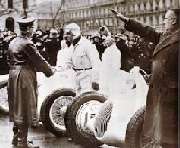 German Dominance
German Dominance
In 1934 the Association Internationale des Automobile Clubs Reconnus (AIACR) announced a new formula, one that
temporarily ended Italian dominance. The formula limited the car minus driver, fuel and oil to 750kg without
restricting engine size. The race length of a Grand Prix was a minimum 500 kilometer.
Mercedes, Porsche and German engineering
Hitler's Germany sponsored two teams to compete under this new formula, Mercedes and Auto Union. Both teams
built brand new cars that were the fastest race cars yet built. Mercedes' chief designer, Dr. Hans Nibel,
designed a car around a conventional layout but incorporating some of the latest development in racing
technology.
Auto Union, an amalgamation of four firms - Horch, Audi, Wanderer and DKW - chose a more radical concept for
their Type A Grand Prix car. Designed by Dr. Ferdinand Porsche, the mid-engined car placed the driver lower
and further towards the front. It had a V16 4.4-litre supercharged engine that ran on special fuels mixed to
a very secret formula. The German cars were beginning to gain their stride. The German cars dominated Grand
Prix Racing, and except for remarkable victories by great drivers such as Chiron and Nuvolari, the Italian and
French cars had to console themselves with the 1.5-liter voiturette class.
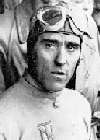 The Greatest Victory of all time - Italy vs Germany
The Greatest Victory of all time - Italy vs Germany
The 1935 German Grand Prix
Before an estimated crowd of 300,000 fanatical German fans, Nazi officials and Adolf Hitler, the German Grand
Prix of 1935 was held. Germany's Mercedes team consisted of Fagioli, von Brauchitsch and Caracciola, while
Auto Union had Stuck, Rosemeyer, and Varzi.
Tazio Nuvolari had wanted to drive for Auto Union but the seat went to his bitter rival. Nuvolari instead drove
a modified Alfa P.3 but suffered from a 50-100 bhp handicap compared to the German cars. At the start of the
race Caracciola surged into the lead followed by Nuvolari who had made a great start. Rosemeyer and Fagioli
soon passed the under-powered Alfa. The race developed into a battle between the two German stars Caracciola
and Rosemeyer, and Nuvolari was all but forgotten. By the 10th lap, Nuvolari had forced himself back into the
lead. A round of pitstops ensued and Nuvolari found himself relegated to sixth place. Driving like a man
possessed he passed first Fagioli, then Rosemeyer and Caracciola, and finally Stuck.
 Going into the last lap
he was still 30 seconds behind the leader von Brauchitsch and all seemed lost, yet never did Nuvolari slow down.
Von Brauchitsch, aware of Nuvolari's progress through the ranks from his pit crew, drove his car at the limit
and in so doing destroyed his tires. One tire let go a half lap from the finish and Nuvolari streaked to
victory. "At first there was deathly silence," MotorSport reported, "and then the innate sportsmanship of the
Germans triumphed over their astonishment. Nuvolari was given a wonderful reception." This admiration for a
great champion was not shared by the representatives of the Third Reich. Korpsf�hrer H�hnlein angrily tore up
his victory speech as Nuvolari was crowned victor. The Italian flag was hoisted after much searching, and to
add salt to the Nazi's wound, Nuvolari produced a record of the Italian anthem that he had brought with him
for good luck. The Korpsf�hrer was not amused, as the Italians defeated the Germans at the height of German
racing dominance.
Going into the last lap
he was still 30 seconds behind the leader von Brauchitsch and all seemed lost, yet never did Nuvolari slow down.
Von Brauchitsch, aware of Nuvolari's progress through the ranks from his pit crew, drove his car at the limit
and in so doing destroyed his tires. One tire let go a half lap from the finish and Nuvolari streaked to
victory. "At first there was deathly silence," MotorSport reported, "and then the innate sportsmanship of the
Germans triumphed over their astonishment. Nuvolari was given a wonderful reception." This admiration for a
great champion was not shared by the representatives of the Third Reich. Korpsf�hrer H�hnlein angrily tore up
his victory speech as Nuvolari was crowned victor. The Italian flag was hoisted after much searching, and to
add salt to the Nazi's wound, Nuvolari produced a record of the Italian anthem that he had brought with him
for good luck. The Korpsf�hrer was not amused, as the Italians defeated the Germans at the height of German
racing dominance.
The fall and rise of Mercedes
1936 was the year of the Auto Union Type C driven by Bernd Rosemeyer. The engine had been enlarged again to
6006cc and produced an astounding 520 bhp. Astounding not so much for its size to horsepower ration, but the
fact that they were able to fit an engine of this size and power into a 750kg formula car. Rosemeyer won German,
Italian and Swiss Grand Prix along with the Eifelrennen and the Coppa Acerbo. Mercedes in fact withdrew from
racing in order to develop their counter-attack. Their independent racing department established in 1935 and
under the direction of 30-year-old engineer Rudolf Uhlenhaut was given a fresh infusion of the best Mercedes
engineers and ordered to develop a brand new car. Mercedes did not disappoint.
 In 1937, Mercedes created a W125 along with a reworked W25, both of them producing nearly 600 bhp, top speeds
reaching 200mph and wheel spin in every gear. The performance of the W125 was unmatched by any other
manufacturer, in fact it would not be until the Can-Am cars of the late 1960s that another race car would
equal the horsepower of the 1937 Mercedes Grand Prix car.
In 1937, Mercedes created a W125 along with a reworked W25, both of them producing nearly 600 bhp, top speeds
reaching 200mph and wheel spin in every gear. The performance of the W125 was unmatched by any other
manufacturer, in fact it would not be until the Can-Am cars of the late 1960s that another race car would
equal the horsepower of the 1937 Mercedes Grand Prix car.
The Avusrennen that year was run on a modified circuit. Reputedly at the suggestion of Adolf Hitler, the North
Curve was rebuilt and steeply banked allowing for much higher speeds. The German cars ran with special
streamlined bodies. Hermann Lang's victory driving a Mercedes at an average speed of 162.61 mph was not bested
for thirty years, when A.J. Foyt averaged 164.173, while winning the Indianapolis 500 in 1967. As a final
exclamation point to these great machines, on January 28, Rudolf Caracciola set a new class record in a
12-cylinder car with special enclosed streamlined body. It set a top speed of 436.9 km/h during a one-kilometer
run in one direction with a flying start. This is the highest speed ever driven on an ordinary road.
The Second World War
In 1938, the AIACR instituted a new formula which limited engine size to 3 liters supercharged or 4.5 liters
unsupercharged. Mercedes and Auto Union answered this new challenge without pause and continued their dominance.
Alfa Romeo abandoned the formula and concentrated on the 1.5-litre voiturette class for their entry in the
Tripoli Grand Prix of 1939. Unbeknownst to Alfa, Mercedes secretly prepared two 1.5-litre W165 cars for Herman
Lang and Caracciola and promptly finished 1-2. Only the outbreak of the Second World War would stop the German
juggernaut. The cars of this era have rightly been considered some of the greatest racing cars ever produced
by man.
To be continued . . . Ferrari fields a car of their own and Nuvolari exits racing in dramatic fashion . . . .



 For many years, Italian automobile manufacturers have been praised for creating beautiful
and powerful machines of style and grace. Never accused of creating a brutta figura, manufacturers such as
For many years, Italian automobile manufacturers have been praised for creating beautiful
and powerful machines of style and grace. Never accused of creating a brutta figura, manufacturers such as
 The following year, a true "race" was run from Paris to Bordeaux and back. This 1895 event was won by Emile Levassor,
driving a 2-cylinder, 4-bhp Panhard-Levassor which he drove for 48 hours 48 minutes virtually non-stop. One
feature of the 1895 event was the Peugeot of Andr� Michelin which used pneumatic tires (in this era, wheels
used on other cars were either iron or solid rubber).
The following year, a true "race" was run from Paris to Bordeaux and back. This 1895 event was won by Emile Levassor,
driving a 2-cylinder, 4-bhp Panhard-Levassor which he drove for 48 hours 48 minutes virtually non-stop. One
feature of the 1895 event was the Peugeot of Andr� Michelin which used pneumatic tires (in this era, wheels
used on other cars were either iron or solid rubber).
 The Italians Take the Lead
The Italians Take the Lead
 Economic Problems and the Advent of War
Economic Problems and the Advent of War
 Racing Returns
Racing Returns
 The growth of the Grand Prix
The growth of the Grand Prix
 Formula Libre
Formula Libre
 Ferrari enters the fold
Ferrari enters the fold
 Despite
Despite  Throughout the 1933 season the top finishes were again shared between the top three Italian teams. And At
Monte Carlo, a journalist by the name of Charles Faroux, made an unusual suggestion. His idea was that drivers
should line up on the grid in positions based on their practise times, rather than by ballot. This is now the
accepted procedure for most forms of motor sport, but back then it was considered quite a novelty. 1933 was
the last year in which races were run under 'Formula Libre' rules. For the next five years control over engine
capacity would be re-established.
Throughout the 1933 season the top finishes were again shared between the top three Italian teams. And At
Monte Carlo, a journalist by the name of Charles Faroux, made an unusual suggestion. His idea was that drivers
should line up on the grid in positions based on their practise times, rather than by ballot. This is now the
accepted procedure for most forms of motor sport, but back then it was considered quite a novelty. 1933 was
the last year in which races were run under 'Formula Libre' rules. For the next five years control over engine
capacity would be re-established.
 German Dominance
German Dominance
 The Greatest Victory of all time - Italy vs Germany
The Greatest Victory of all time - Italy vs Germany
 Going into the last lap
he was still 30 seconds behind the leader von Brauchitsch and all seemed lost, yet never did Nuvolari slow down.
Von Brauchitsch, aware of Nuvolari's progress through the ranks from his pit crew, drove his car at the limit
and in so doing destroyed his tires. One tire let go a half lap from the finish and Nuvolari streaked to
victory. "At first there was deathly silence," MotorSport reported, "and then the innate sportsmanship of the
Germans triumphed over their astonishment. Nuvolari was given a wonderful reception." This admiration for a
great champion was not shared by the representatives of the Third Reich. Korpsf�hrer H�hnlein angrily tore up
his victory speech as Nuvolari was crowned victor. The Italian flag was hoisted after much searching, and to
add salt to the Nazi's wound, Nuvolari produced a record of the Italian anthem that he had brought with him
for good luck. The Korpsf�hrer was not amused, as the Italians defeated the Germans at the height of German
racing dominance.
Going into the last lap
he was still 30 seconds behind the leader von Brauchitsch and all seemed lost, yet never did Nuvolari slow down.
Von Brauchitsch, aware of Nuvolari's progress through the ranks from his pit crew, drove his car at the limit
and in so doing destroyed his tires. One tire let go a half lap from the finish and Nuvolari streaked to
victory. "At first there was deathly silence," MotorSport reported, "and then the innate sportsmanship of the
Germans triumphed over their astonishment. Nuvolari was given a wonderful reception." This admiration for a
great champion was not shared by the representatives of the Third Reich. Korpsf�hrer H�hnlein angrily tore up
his victory speech as Nuvolari was crowned victor. The Italian flag was hoisted after much searching, and to
add salt to the Nazi's wound, Nuvolari produced a record of the Italian anthem that he had brought with him
for good luck. The Korpsf�hrer was not amused, as the Italians defeated the Germans at the height of German
racing dominance.
 In 1937, Mercedes created a W125 along with a reworked W25, both of them producing nearly 600 bhp, top speeds
reaching 200mph and wheel spin in every gear. The performance of the W125 was unmatched by any other
manufacturer, in fact it would not be until the Can-Am cars of the late 1960s that another race car would
equal the horsepower of the 1937 Mercedes Grand Prix car.
In 1937, Mercedes created a W125 along with a reworked W25, both of them producing nearly 600 bhp, top speeds
reaching 200mph and wheel spin in every gear. The performance of the W125 was unmatched by any other
manufacturer, in fact it would not be until the Can-Am cars of the late 1960s that another race car would
equal the horsepower of the 1937 Mercedes Grand Prix car.